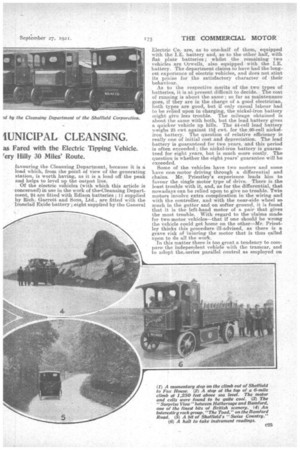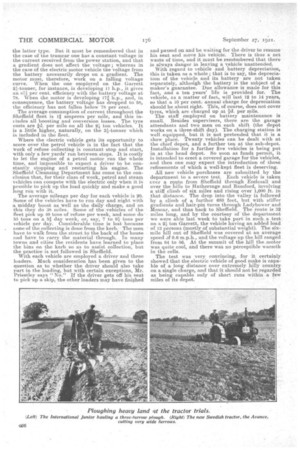THE ELECTRIC VEHICI IUNICIPAL CLEANSING.
Page 14

Page 15

Page 16

If you've noticed an error in this article please click here to report it so we can fix it.
How the Sheffield, Corporation's Cleansing I At Interesting Dernonstrat as Fared with the Electric Tipping Vehicle. rery Hilly 30 Miles' Route.
THE work of a municipal cleansing department is never showy. It is essential, and may be very effective, under a good superintendent, but, being a upending department, it does not produce a shower Of bouquets, and, therefore, it offers no margin for extravagances or even for frills.
Hence it is the duty o,f the superintendent and his staff to watch every item of expenditure and to secure the maximum of efficiency. The cleansing department of one city will, where reasonably possible, carefully examine the methods and results attained by a similar department in another centre, and there is always a willingness for a close interchange of experiences and opinions, so that useful and reliable information may be obtained. But opportunities do not often occur for this interchange, as the superintendents are busy men, and, besides the expenditure of tine, it is nowadays comparatively costly to go about and inspect the doings in a town, perhaps some distance off, where the conditions are sufficiently alike to make comparison useful.
Therefore, in describing the work of the cleansing department of a big city such as Sheffield, with a large population spread over a hilly district, we hope that we shall be rendering a service to other similar administrations.
Sheffield has a fleet of 45 electric vehicles engaged in refuse collecting, the department being under the charge of Mr. J. A. Priestley, the superintendent. The use of horsed vans, electric and steam vehicles has been carefully tested, and it has been found that, within a radius of half a mile from the depot and with a maximum distance per single load of three miles (out and home), the hors,ed vehicle is still the best. But for any work more than half a mile from the depot, or where the total out and home distance exceeds three miles, the electric vehicle is best on the score of economy.
Electric current for the electric battery vehicles is obtained from the Electricity Supply Department of the Corporation at 2,000 volts alternating current, and is transformed to 94-100 volts direct current. A small proportion of the power requirements of the Cleansing Department is obtained from generators driven by steam plant fed by fuel from the destructor,
and it is the intention largely to develop the present scheme of refuse destruction and to utilize more home-produced power. The switchboard at the depot allows for charging the batteries from either one or both of the sources of currant. The current from the Electricity Supply Department is charged to the Cleansing Department at lid. per unit, the latter meeting the losses in conversion, etc. This price, whilst moderate, is not looked upon as in any way favouring the Cleansing Department, because it is a load which, from the point of view of the generating station, is worth having, as it is a load off the peak and helps to level up the output line. • Of the electric vehicles with which this article is concerned) in use in the work of the.Oleansing Department, 24 are fitted with Edison batteries ; 11 supplied by Rich. Garrett and Sons, Ltd., are fitted with the Ironclad Exide battery ; eight supplied by the General Electric Co. are, as to one-half of them, equipped with the I.E. battery and, as to the other half, with flat plate batteries ; whilst the remaining two vehicles are Orwells, also equipped with the I.E. battery. The department claims to have had the long-. est experience of electric vehicles, and does not stint its praise for the satisfactory character of their. behaviour.
As to the respective merits of the two types of batteries, it is at present difficult to decide. The cost of running is about the same ; so far as maintenance goes' if they are in the charge of a good electrician, both types are good, but if only casual labour had to be relied upon in charging, the nickel-iron battery might give less trouble. The mileage obtained is about the same with both, but the lead battery gives a quicker vehicle up hills. The 44-cell lead battery weighs 25 cwt against 15i• cwt. for the_60-cell nickeliron battery. The question of relative efficiency is really one of initial cost and depreciation. The lead battery is guaranteed for two years, and this period is often exceeded ; the nickel-iron battery is guaranteed for eight years, but is much more costly. The question is whether the eight years' guarantee will be exceeded.
Some of the. vehicles have two motors and some have one? motor driving through a differential and chains. Mr. Priestley's experience leads him to favour the single motor type of drive. There is the least trouble with it, and, as for the differential, that nowadays can be relied upon to give no trouble. Twin motors involve extra complication in the wiring and with the controller, and with the near-side wheel so much in the gutter and on softer ground, it is found that it is the left-hand motor of a pair that gives the most trouble. With regard to the claims made for two-motor vehicles—that if one should be wrong the vehicle could get home on the other—Mr. Priestley thinks this procedure ill-advised, as there is a grave risk of injuring the motor that is thus called upon to do all the work.
In this matter there is too great a tendency to compare the independent vehicle with the tramcar, and to adopt the,series parallel control as employed on
the latter type. But it must be remembered that in the case of the tramcar one has a constant voltage in the current received from the power station, and that a gradient does -not affect the voltage ; whereas in the case of the electric motor vehicle the voltage from the battery necessarily drops on a gradient. The motor must, therefore, work on a falling voltage curve. When the one employed on the Garrett 2.1J-torn:Ler, for instance, is developing 11 h.p., it gives an s7 per cent. efficiency with the battery voltage at 75. When the motor is developing 171 h.p., and, in consequence, the battery voltage has dropped to 58, the efficiency has not fallen below 75 per cent.
The average consumption of current throughout the Sheffield fleet is ii amperes per mile, and this includes all boosting and conversion losses. The tyre costs are id. per mile on all the W.,ton vehicles. It is a little higher, naturally, on the 31-tonner which is included in the fleet.
Where the electric vehicle gets its opportunity to score over the petrol vehicle is in the fact that the work of refuse collecting is constant stop and start, with only a few yards' run between stops. It is costly to let the engine of a petrol motor run the whole time, and impossible to expect a driver to be constantly stopping and restarting his engine. The Sheffield Cleansing Department has come to the conclusion that, for their class of work, petrol and steam vehicles can compete with the electric only when it is possible to pick up the load quickly and make a good long inn with it.
The average mileage per day for each vehicle is 20. Some of the vehicles have to run day and night with a midday boost as well as the daily charge, and on this they do 35 miles. 'Some of the ',vehicles of -the fleet pick up 40 tOns of 'refuse per week, and some do • .53 tons on a 4 day week, or say", 7 to 9:1 tons per vehicle per day. Considerable time is lost • because hone of the collecting is done from the kerb:. The men have to walk from the street to the back of the house and have to carry the material through. In many towns and cities the residents have learned to 'place the bins on the kerb 'so as to assist collection, but the practice is not :followed in Sheffield.
With each vehicle are employed a driver and three loaders. Much consideration has been given to the question as to whether the driver should also take part in the loading,' but with certain exceptions, Mr. Priestley says "No." If the driver gets off his seat to pick up a skip, the other loaders may have finished and passed on and be waiting for the driver to resume his seat and move his vehicle'. There is thus a net waste of time, and it must be rem6mbered that there is always danger in leaving a vehicle unattended. With regard to vehicle and battery depreciation, this is taken as a whole ; that is to say, the depreciation of the vehicle and its battery are not taken separately, although the battery is the subject of a maker's guarantee. Due allowance is made for this fact, and a ten years' life is provided for. The vehicle, as a matter of fact, will last /2 to 14 years, so that a 10 per cent. annual charge for depreciation should be about right. This, of course, does not cover yr es, which are .charged up at Id'. per mile. The staff employed on battery maintenance is small. Besides supervisers, there are the garage attendants and two men, on each shift (the depot works on a three-shift day). The charging station is well equipped, but it is not pretended that it is a show place. Twenty vehicles can be dealt with at the chief depot, and a further ten at the sub-depot. Installation for a further five vehicles is being put in at the head depot. So soon as funds permit, it is intended to erect a covered garage for the vehicles, and then one may expect the introduction of those refinements of which a well-kept fleet is deserving.
All new vehicle purchases are submitted by the department to a severe test. Each vehicle is taken ever a route from Sheffield through Eeelesall and over the hills to Hathersage and Bamford, involving a stiff climb of six miles and rising over 1,000 ft. in that distance. The drop into the valley is followed by a climb of a further 680 feet, but with stiffer gradients and hair-pin turns through Laclybower an& Moscar, and thus back to Sheffield. The route is 32 miles long, and by the courtesy of the department we were able last week to take part in such, a test on a 21 ton Garrett, the vehicle having an added load of 13 persons (mostly of substantial weight). The sixmile hill out of Sheffield was covered at an average speed 9.6 m.p.h., and the voltage up the hill ranged from 54 to 86. At the summit of the hill the .motor was quite cool, and there was no perceptible warmth in the cells.
The test was very convincing, for it certainly showed that the electric vehicle of good make is capable of a long distance Over extremely hilly country on a•Single charge; and that it 'should not be regarded as being capable only of short runs within .a few miles of its depot.


































